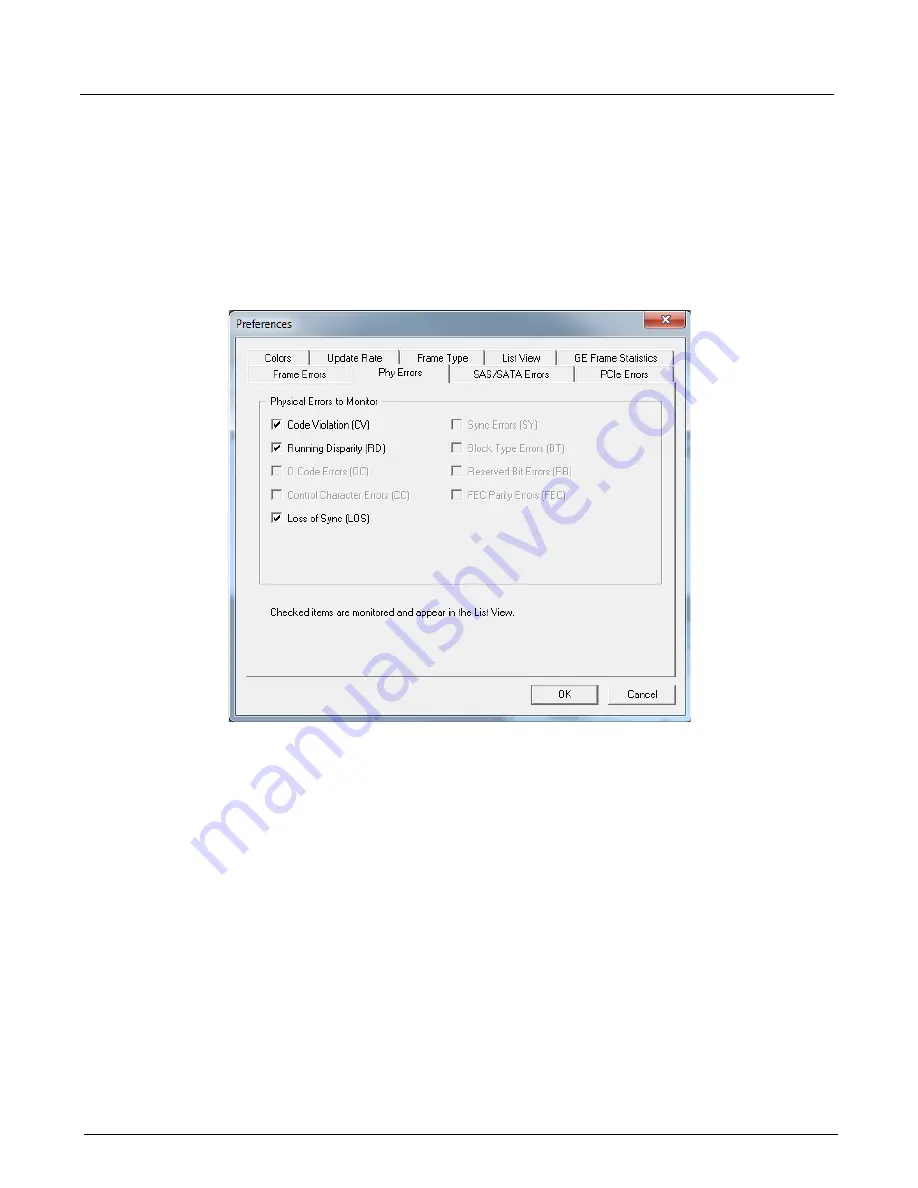
Chapter 10, Xgig Performance Monitor Configuration
Performance Monitor Options
200
Xgig Analyzer User’s Guide
Phy Errors
Select the
Phy Errors
tab to choose which errors should be counted and displayed in the
List
View
.
Check the box for all error types to count and display. For example, if you want to count
only CV errors, leave all boxes unchecked with the exception of CV errors.
Boxes for selecting an error counter are grayed out if they are not supported for the ports being
monitored. This does not apply to Loss of Sync (LOS) errors.
Figure 85: Phy Error Display Preference
Unselected error types are not used in determining the value of a status LED for a port (see Status
LEDs). For example, if CV errors are not selected, and the only errors detected for a port are CV
errors, the status light for that port will remain green. Loss of Sync (LOS) errors are only available
for PCIe ports.
For Xgig ports, columns for each selected error type that can be counted are displayed in List
View. For Xgig ports, columns for unselected error types are not shown. For example, if CV errors
are not selected, the CV Errors column will not display. For “state” errors, such as Loss of Signal
or Loss of Sync, the current state will appear in the
Traffic Status
column.
Remote Xgig hosts may contain a mix of Xgig Analyzer ports that use different protocols and
therefore have different error counters. If the Xgig host contains multiple port types that have
different error counters, you will be able to select any counter that applies to least one of the ports
in the host. In
List View
, the error counter will be marked with label N/A if the counter does not
apply for a specific port on the host.
Summary of Contents for Xgig
Page 1: ...Xgig Analyzer Version 7 3 User s Guide ...
Page 2: ......
Page 3: ...Viavi Solutions 1 844 GO VIAVI www viavisolutions com Xgig Analyzer Version 7 3 User s Guide ...
Page 6: ...Xgig Analyzer User s Guide Page iv Version 7 3 December 2015 ...
Page 7: ...v CONTENTS ...
Page 15: ...1 PART ONE Using Xgig Analyzer ...
Page 16: ...PART ONE Using Xgig Analyzer 2 Xgig Analyzer User s Guide ...
Page 27: ...13 PART TWO Using Xgig TraceControl ...
Page 28: ...PART TWO Using Xgig TraceControl 14 Xgig Analyzer User s Guide ...
Page 29: ...15 Chapter 2 About Xgig TraceControl In this chapter Introduction to TraceControl ...
Page 176: ...Chapter 6 Xgig TraceControl Hints and Tips Keyboard Shortcuts 162 Xgig Analyzer User s Guide ...
Page 177: ...163 PART THREE Using Xgig Performance Monitor ...
Page 178: ...PART THREE Using Xgig Performance Monitor 164 Xgig Analyzer User s Guide ...
Page 223: ...209 PART FOUR Using Xgig TraceView ...
Page 224: ...PART FOUR Using Xgig TraceView 210 Xgig Analyzer User s Guide ...
Page 225: ...211 Chapter 11 About Xgig TraceView In this chapter Introducing Xgig TraceView ...
Page 382: ...Chapter 15 Xgig TraceView Histograms Histogram Controls 368 Xgig Analyzer User s Guide ...
Page 383: ...369 Chapter 16 Xgig TraceView Template Editor In this chapter Using Template Editor ...
Page 437: ...423 PART FIVE Using Xgig Expert ...
Page 438: ...PART FIVE Using Xgig Expert 424 Xgig Analyzer User s Guide ...
Page 442: ...Chapter 21 Xgig Expert 428 Xgig Analyzer User s Guide Figure 194 Xgig Expert Graph View ...
Page 443: ...429 PART SIX Appendices ...
Page 444: ...PART SIX Appendices 430 Xgig Analyzer User s Guide ...
Page 454: ...Appendix C Protocol Display Color Coding 440 Xgig Analyzer User s Guide ...
Page 461: ...447 INDEX ...
Page 467: ......






























